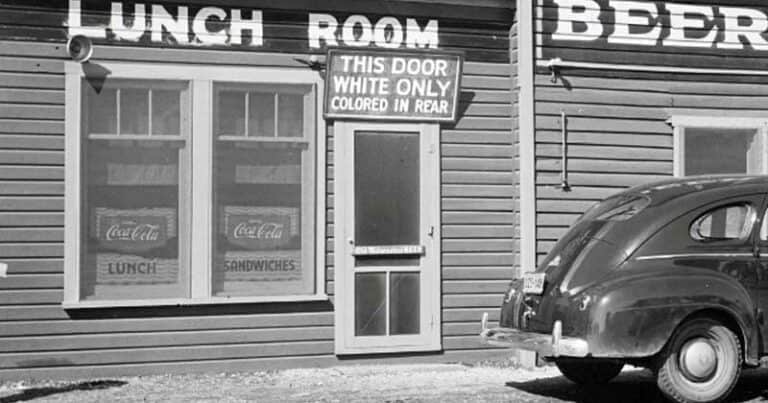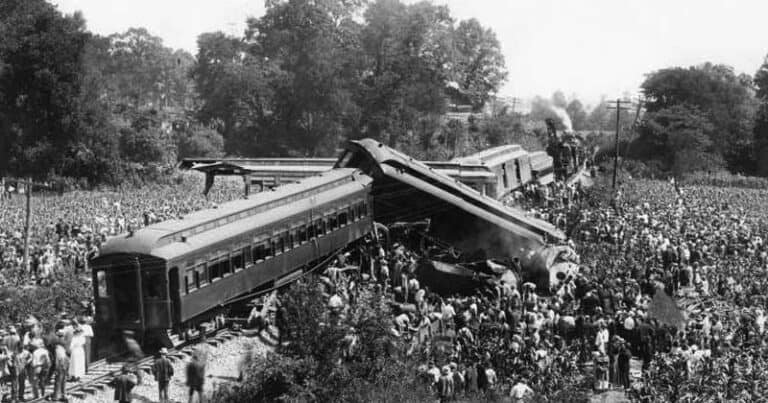The American Freedom Train, Patriot on Rails
With its ties to mining and manufacturing, the railroad industry played a huge role in the development of America. Railroads tie the country together. It’s not just freight. Passengers too. And special trains.
Railroads became the way for politicians to campaign, for the circus to travel between towns, and two times those tracks that tie the country together hosted a patriotic train tour. Dubbed the “American Freedom Train” each of these trains visited every one of the 48 contiguous states. Sorry Hawaii and Alaska! Let’s take a look at these special trains, put on the rails to celebrate the liberty that Americans rightly treasure.

Both trains would feature patriotic colors on their passenger cars and locomotives, and carry artifacts and displays about the American experience. Interestingly each Freedom Train would be powered by different types of locomotives – although each were rare and of special interest to the public at the time.
The Freedom Train (1946-1949)
Plans for the first Freedom Train were introduced by US Attorney General Tom C. Clark in April 1946. There was a renewed sense of patriotism during and shortly following World War II, which had officially ended the previous September, but Clark believed that Americans were taking freedom for granted.
He sensed the boost in patriotism was beginning to subside, so he joined the American Ad Council, Paramount Pictures, various civic groups – and America’s railroads – to make a “Freedom Train” a reality.

The Freedom Train was led by an ALCo PA Diesel locomotive that was given number 1776 and nicknamed “Spirit of 1776”. Large mainline diesel locomotives were new, so the locomotive provided many visitors with their first close up experience with the new type of locomotive and inadvertently served as an advertisement that sped up dieselization throughout the country.
The tour began in Philadelphia on September 17th, 1947, and would tour then all 48 states over the next 13 months. The train featured multiple exhibits and historical documents including the Declaration of Independence, Bill of Rights, and US Constitution among them. Due to the importance of the documents, security and crowd control was provided by Marines that were hand selected for the honor.

Controversy in the South
Controversy arose when the train began to visit states in the South. African-American author Langston Hughes wrote a poem titled “Freedom Train”. The poem pointed out the Freedom Train was still segregated in the South. The foundation that sponsored the AFT was determined to open the train to all, without respect to creed or color.
The Jim Crow bigotry laws in the South stood in the way of the foundations lofty goal. For more about the controversy, including the poem “Freedom Train”, see our article, The Freedom Train Brought Freedom.
The poem and the related public response led the Truman administration to announce that the train would be desegregated for the tour. Although this policy was accepted at most cities on the tour schedule, stops in Memphis and Birmingham were cancelled after city leaders refused to have desegregated visiting hours.

By the time the 1946/1947/1948 Freedom Train into Havre de Grace, Maryland, for her last official appearance on October 26, 1948, the Freedom Train had visited more than 300 cities across the country. The tour would officially end in Washington DC the following January.
The American Freedom Train (1975-76)
Nearly three decades after the Freedom Train toured the country, Ross Rowland Jr., a businessman and locomotive engineer, wanted to celebrate America’s upcoming Bicentennial. Rowland and a group of friends knew the crowds that a stream train exhibit would draw, so in 1974 they began planning a touring exhibit of American culture and artifacts, similar to the original Freedom Train, which would be called the American Freedom Train (AFT).

Rowland began putting his ideas into action a few years before the bicentennial. It’s a good thing as sponsorships and securing the locomotives took organizers right up to the wire. Fortunately, when Opening Day happened in April 1975, the train was ready to steam. During the three years of the American Freedom Train, the train was led by 3 different steam locomotives.
Three Steam Engines Share the Lead Position
- Reading #2101 led the train throughout the eastern portion of the United States. Built by Baldwin in 1923, the locomotive was converted to a 4-8-4 wheel arrangement at Reading’s shops in 1945. Her participation in the AFT was remarkable because crews had just 30 days to restore her both mechanically and cosmetically; and the locomotive was not in great shape at the time after many years in the scrap line.
- Texas & Pacific #610, a 2-10-4 (Texas Type) locomotive built by Lima in 1925, was selected to pull the train through the “Lone Star” state. Similar to Reading #2101, T&P #610 was static as the time of her selection and required significant work to get her ready. Following the AFT, she was able to enter excursion service.
- Southern Pacific #4449, a streamlined 4-8-4 built by Lima in 1941, had the honors of leading the tour through the western half of the US. Since the American Freedom Train in 1975/1976, #4449 has remained in active excursion service. 4449 owes her second life to the bicentennial Freedom Train, as she was winched from a Portland city park and restored to operating condition just for this train.
Criss-crossing the Country
Between opening day on April 1, 1975, and the final day on December 31, 1976, the locomotives led the tour across the contiguous 48 United States and made stops to be on display in 138 cities. This Freedom Train came with 26 cars, 10 of them were special display cars. The display cars were again filled with displays and artifacts of the founding of our country.
At each stop the lines were long, and occasionally slow, as Americans would get a close-up of items as diverse as George Washington’s personal copy of the Constitution…and Judy Garland’s dress from the movie “Wizard of Oz”. Even a moon rock, from America’s recent success in space, was on the train.

Organizers estimate that 7 million people visited the train over the course of the tour, and that doesn’t include the countless number of children and adults who visited nearby tracks to catch the train as it chugged through the country. The last visitor boarded the train, and gawked at the displays, on December 31st, 1976.

Post American Freedom Train Tour
Following the tour, the three locomotives went their separate ways. Fortunately all three locomotives are still preserved today. #4449 continues to steam up for excursion trips in the Pacific Northwest while #2101, now at the B&O Museum, and #610 with the Texas State Railroad are preserved on static display.
The specially modified American Freedom Train display cars had a surprising second life. In 1977 the National Museums of Canada, a nine museum consortium, purchased 15 of the cars. After a quick refurbishment, and stocking the display cars with documents and artifacts from Canada, the “Discovery Train” began a three year tour of Canada. It too was a success.
Canadian National and Canadian Pacific pulled the grain free of charge. Nearly 100 cities and towns, and every province, were on the schedule. The train logged thousands of miles during 1978, 1979 and 1980.
The train carried displays on the prehistoric era in Canada, First Nations and the Inuit, and then history and documents of “New France”, British North America, World War 1 and the many Canadian achievements in World War 2, modern Canada was represented as well.
For more information about the American Freedom Train and the two national tours, visit this website dedicated to the history of the AFT.
SP 4449 dressed patriotic one more time
The “Friends of the 4449” had welcomed their now nationally famous steam locomotive back to Portland with open arms…and plans for the future. Indeed since that time 4449 has really only been sidelined for a couple of years for a complete boiler overhaul as mandated by the Federal Government.

After the terrorist attacks of September 11, 2001, Southern Pacific 4449, by now known as “The Daylight” was once again painted in her Red, White and Blue American Freedom Train uniform. For a couple of years, this patriotic steamer wowed the Pacific Northwest. Read more about this incarnation of patriotic steam in our article, “Patriotic Steam in the Pacific Northwest”.
Who knows, this could happen again. In each case, the project began as the idea of one person. Maybe we just await a new person, with an old idea, to take charge again.




